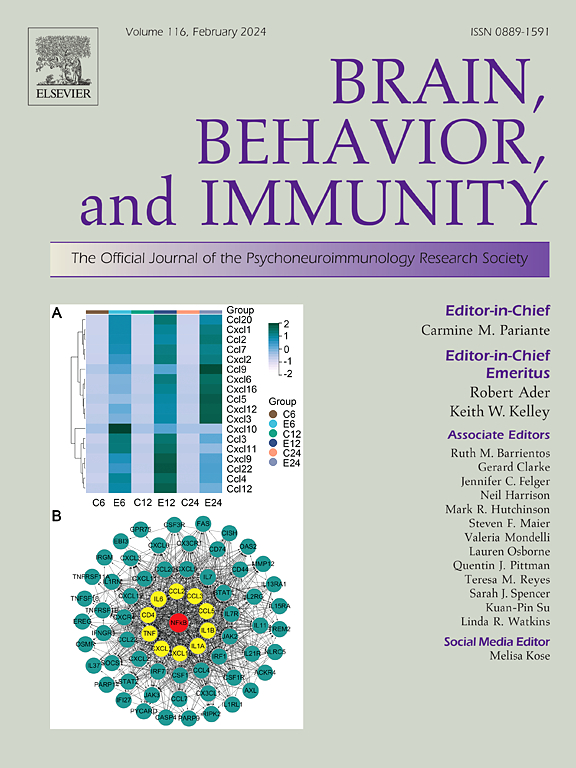Il-6敲除可减少发育中的小鼠大脑中阿霉素引起的毒性
IF 7.6
2区 医学
Q1 IMMUNOLOGY
引用次数: 0
摘要
目的:多柔比星(DXR)治疗与癌症患者的认知障碍有关,包括儿科幸存者。然而,由于DXR不容易穿过血脑屏障,DXR诱导的促炎细胞因子升高等系统性机制可能是介导神经毒性的关键。使用儿童癌症治疗小鼠模型,我们研究了DXR治疗后的细胞因子水平,并通过基因敲除评估其对脑毒性的影响。实验设计小鼠在儿童等效年龄(P17和P19)给予DXR治疗,在P20时处死,以测量血浆和脑组织中细胞因子的水平。DXR治疗后,两组患者IL-6均显著升高。我们使用纵向体内MRI(从P14到P98)评估脑容量变化,并进行组织学分析以进一步探索DXR对野生型和Il-6敲除小鼠脑的影响。结果dxr治疗引起大范围脑容量减少。在用DXR治疗的Il-6敲除小鼠中,脑容量减少部分得到恢复,随着时间的推移,脑容量逐渐改善。此外,组织学分析显示,在DXR治疗的野生型小鼠中,促炎小胶质细胞标志物CD68增加,而在Il-6敲除小鼠中,这一反应得到了缓解。结论IL-6在DXR诱导的脑毒性中起一定作用,为DXR通过血脑屏障的作用提供了可能的机制。该研究还提供证据表明,靶向IL-6可能减轻化疗与脑结构改变相关的副作用,如接受DXR治疗的癌症幸存者的认知缺陷。本文章由计算机程序翻译,如有差异,请以英文原文为准。
Il-6 knockout reduces doxorubicin-induced toxicity in the developing mouse brain
Purpose
Doxorubicin (DXR) treatment is linked to cognitive impairments in cancer patients, including pediatric survivors. However, since DXR does not readily cross the blood–brain barrier, systemic mechanisms such as DXR-induced elevations of pro-inflammatory cytokines may be key in mediating neurotoxicity. Using a mouse model of pediatric cancer treatment, we investigated cytokine levels following DXR treatment and evaluated its effects on brain toxicity through genetic knockout.
Experimental design
Mice were treated with DXR at a childhood-equivalent age (P17 and P19) and sacrificed at P20 to measure cytokine levels in plasma and brain tissue. IL-6 was significantly elevated in both after DXR treatment. We assessed brain volume alterations using longitudinal in vivo MRI (from P14 to P98) and performed histological analysis to further explore DXR impact on the brain in wildtype and Il-6 knockout mice.
Results
DXR treatment caused widespread brain volume reductions. The volume reductions were partially rescued in Il-6 knockout mice treated with DXR, which showed progressive brain volume improvements over time. Additionally, histological analysis revealed an increase in the pro-inflammatory microglial marker CD68 in wildtype mice treated with DXR, a response that was mitigated in Il-6 knockout mice.
Conclusions
Our results indicate that IL-6 plays a role in DXR-induced brain toxicity, offering a potential mechanism by which DXR affects the brain despite its limited penetration of the blood–brain barrier. This study also provides evidence that targeting IL-6 may alleviate side effects of chemotherapy associated with structural brain changes, such as cognitive deficits in cancer survivors treated with DXR.
求助全文
通过发布文献求助,成功后即可免费获取论文全文。
去求助
来源期刊
CiteScore
29.60
自引率
2.00%
发文量
290
审稿时长
28 days
期刊介绍:
Established in 1987, Brain, Behavior, and Immunity proudly serves as the official journal of the Psychoneuroimmunology Research Society (PNIRS). This pioneering journal is dedicated to publishing peer-reviewed basic, experimental, and clinical studies that explore the intricate interactions among behavioral, neural, endocrine, and immune systems in both humans and animals.
As an international and interdisciplinary platform, Brain, Behavior, and Immunity focuses on original research spanning neuroscience, immunology, integrative physiology, behavioral biology, psychiatry, psychology, and clinical medicine. The journal is inclusive of research conducted at various levels, including molecular, cellular, social, and whole organism perspectives. With a commitment to efficiency, the journal facilitates online submission and review, ensuring timely publication of experimental results. Manuscripts typically undergo peer review and are returned to authors within 30 days of submission. It's worth noting that Brain, Behavior, and Immunity, published eight times a year, does not impose submission fees or page charges, fostering an open and accessible platform for scientific discourse.

 求助内容:
求助内容: 应助结果提醒方式:
应助结果提醒方式:


